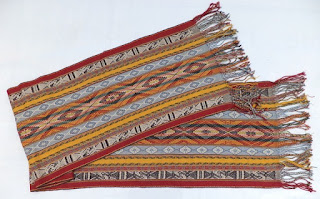Volunteer Leah Hughes in Cusco | Part II
Week Two
 |
| A beautiful table runner |
Last weekend we visited the communities of Parobamba, Bombón and Pitukiska. These three communities are a few hours away from Cusco in the Mapacho River Valley. To get there we hired a private car (although normally we go by bus), then rode in cattle trucks and walked until we had visited all three villages. I shadowed Ashli during the meetings so I will know how to lead the meetings myself once she is back in Canada. We were quite a large group, since we went with a couple other volunteers who are working with Mosqoy this month as well as two Mosqoy students. I will always have a Mosqoy student with me at meetings to act as a Quechua-Spanish interpreter. When we arrived, I was first struck by the beauty of our surroundings. Bombón, for example, is a tiny village perched on a mountaintop and is accessible only by a road cut straight out of the steep cliff face. From the clearing where the meetings are held, you look out over a misty green river valley and surrounding mountain peaks. Pitukiska, on the other hand, is a tiny grouping of stone houses nestled into the head of a valley. We had quite the vantage spot from the wall of a home high up on the hill!
 |
| Catching up on notes in Pitukiska |
After a spectacular three days in the Andean countryside, I returned to the city and got to work tagging and doing inventory on the textiles we bought over the weekend.
 |
| Weaving meeting in Parobamba |
We got them all ready and sent a large shipment of textiles back to Victoria yesterday. Hopefully they will arrive just in time for upcoming Christmas fairs in Canada. Now that I’ve seen exactly where they come from, I have an even greater appreciation for the value of these beautiful products. As I was typing up meeting minutes yesterday, I read in my notes that it takes a weaver two six-hour days of weaving to make one belt! I feel privileged to have the opportunity to travel to these communities and meet each individual weaver. It is an amazing experience to visit these remote places and see how the weavers live. I feel honoured to be so warmly welcomed into their lives and homes. I hope the work I do during my stay here truly helps to sustain the incredible textile tradition of these talented weavers.


Comments
Post a Comment